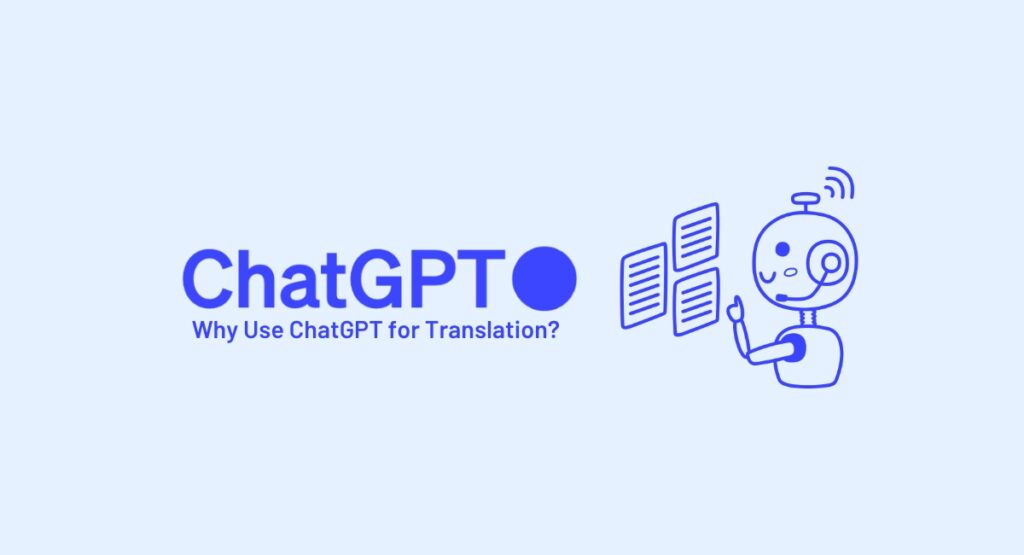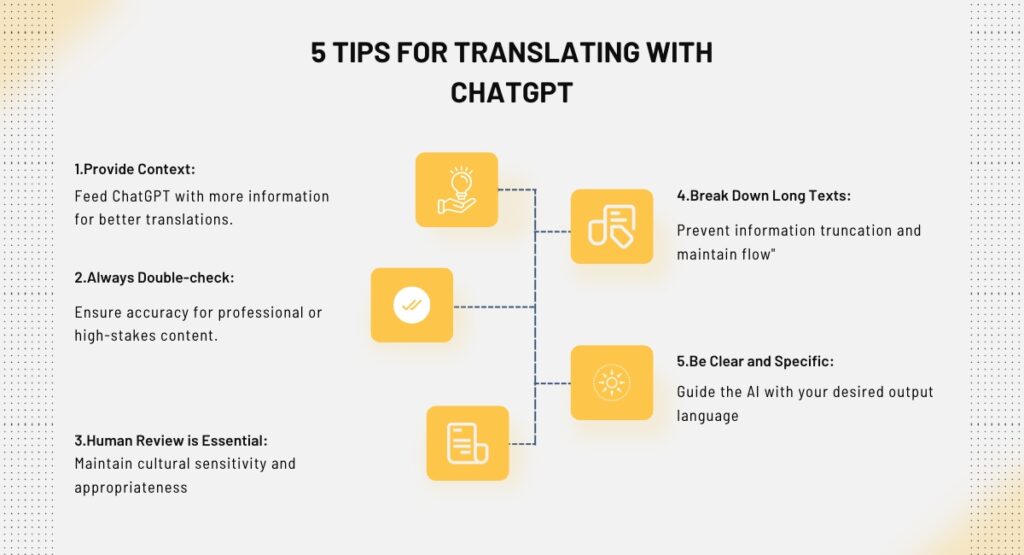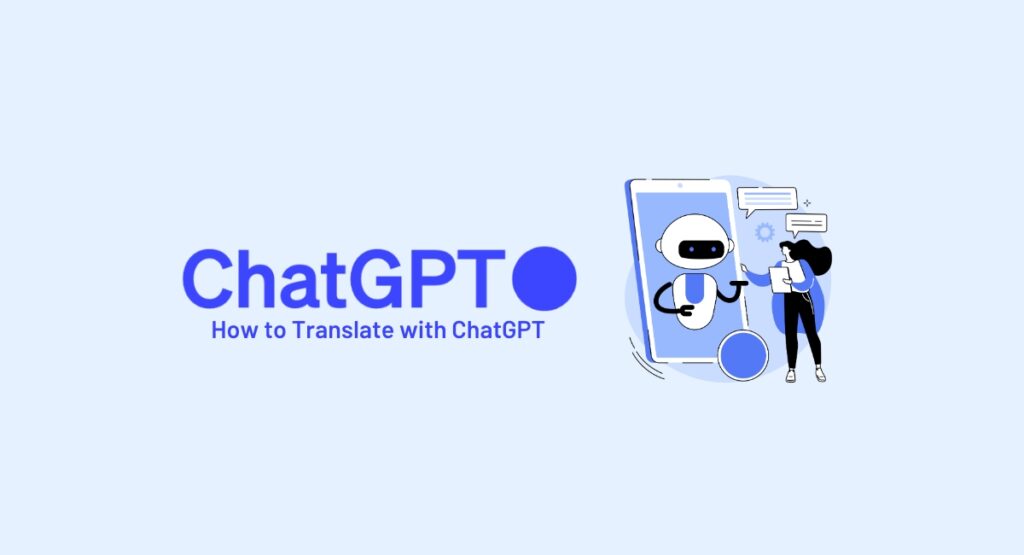OpenAI’s ChatGPT, an AI (artificial intelligence) chatbot, was first introduced in November 2022. The AI quickly rose to prominence for allowing users to have conversations and use the chatbot for various applications. One such application that has become popular is ChatGPT’s translation capabilities.
With the need for accurate translations growing in global communications, ChatGPT is proving itself to be an invaluable tool. Accurate translations are needed more than ever as businesses look to make their products and services available to the global market.
Table of Contents
Why Use ChatGPT for Translation?

With the AI need for accurate translations growing each year, tools like ChatGPT can make a human translator’s job faster and easier. Chatbots are being used by creatives around the world as an aid in their creative process. Translators have found the tool to be useful in their work, too.
For one thing, OpenAI’s ChatGPT allows for faster turnarounds; it offers one of the most advanced translation tools available today, and more. The chatbot is an excellent tool for producing initial translations, which human translators can tweak.
The future of the translation industry is tied to AI tools, including ChatGPT. But there are some considerations to using this tool for translations. In this article, we discuss using OpenAI’s ChatGPT for translation, tips for using the chatbot as an accurate translation tool, and more.
The Science Behind ChatGPT’s Translation Ability
OpenAI’s ChatGPT uses deep learning algorithms to analyze text prompts made by the human user. The chatbot then generates responses based on patterns it finds in the database it was trained on. The AI was trained on a diverse range of Internet text; however, it cannot discern which documents were in its training set, and it does not have access to any proprietary databases or specific documents.
The database used to train ChatGPT included a large body of text, such as books, websites, articles, and more. All of this data helped the chatbot learn and understand the nuances of human language and to produce high-quality responses (in most cases).
Some people have asked if the chatbot uses Google Translate. The answer is no. The AI training process that was used with ChatGPT has enabled the AI to translate text accurately across various languages.
5 Tips for Translating with ChatGPT

When using a tool such as Google Translate, the translated text is a literal translation. There is no nuance, no understanding of context, etc. On the other hand, what makes OpenAI’s ChatGPT a better translation tool is that the chatbot has the ability to dig deeper into the meaning of the text. However, it’s necessary to provide the AI with some context. The translation is of a higher quality when the chatbot has more information.
Providing more context allows the AI to generate translated text that’s of higher quality and with fewer mistakes. Context can include information about the style, tone of voice, giving the AI a deeper understanding of the situation, and more.
While ChatGPT can produce remarkably accurate translations, the tool is not infallible. So, it’s recommended that you always double-check the output, especially for high-stakes or professional content.
Another issue is that ChatGPT needs a deeper understanding of cultural nuances. For this reason, having a human review of the generated translation is essential to maintain cultural sensitivity and appropriateness.
When it comes to longer texts, it’s best to break them down into shorter segments. This prevents the model from truncating important information while maintaining the flow of translation.
Moreover, it’s essential to provide OpenAI’s ChatGPT with clear, specific instructions. For example, if you want a text translated from English to French, explicitly state this in your input to the model.
Finally, remember that the AI is a tool that can facilitate the process, but it should be used responsibly and always in combination with human expertise for the best translation results.
Don’t rely solely on Machine Translation
There’s no question that OpenAI’s ChatGPT is a remarkable translation tool. For now, this and other AI tools must be used with human oversite to ensure high-quality translations. ChatGPT was not created for translation work, which surprises many people.
Human translators are needed to ensure that all translations are accurate. They also understand the text and all of its nuances, which the chatbot does not. The AI tool also lacks creativity; translation is more than just generating a literal translation.
Moreover, human translators must ensure the text translated by the AI is consistent, with the appropriate style, terminology, and more. Additionally, human translators ensure the translation’s localization and resonance with the intended target audience.
How to Translate with ChatGPT

Contextual Translation
As noted earlier, OpenAI’s ChatGPT needs context to provide the most accurate translations. For instance, when translating “Estoy lleno” from Spanish to English could be interpreted as “I am full;” however, in context, it might be more appropriate to mean “I’ve had enough.”
Contextual translation with ChatGPT is much different from using Google Translate. When using Google Translate, the output remains static, irrespective of how many times you run the translation. On the other hand, ChatGPT tends to provide the most accurate translation based on the provided context. Here are some examples to consider that show how to provide the chatbot with more context for a quality translation:
- “Translate [text to translate in French] to English from the viewpoint of a native French Speaker.”
- “Translate [text to translate] to English. The text discusses the ongoing environmental crisis.”
- “Translate [text to translate] to English. The text refers to a famous artwork.”
Specify text type: ChatGPT’s translation accuracy improves when the type of text (e.g., poem, legal document, casual conversation) is specified.
- Example: “Translate this medical prescription in quotes to English.”
Style transfer: ChatGPT can adjust the style and tone of the translation to match the target audience or context.
- Example: “Translate this medical document to English in simple language.”
Geographical variance: ChatGPT can account for regional differences in language and offer suitable translation.
- Example: “Translate ‘I’m going to play football’ to Spanish from an American English speaker’s perspective.”
Summarized translation: Sometimes, you may only require the key points of a document. In such cases, you can request a summarized translation from ChatGPT using commands such as:
- “Provide a brief translation of [text to translate] in German.”
- “Provide a condensed translation of [text to translated] in Italian.”
- “Translate this document into Russian, focusing on the main ideas.”
Fine-tuning ChatGPT: A more refined approach involves fine-tuning ChatGPT by providing it with translation rules or larger texts with their validated translations.
- Example: “Provide a word-translation pair to fine-tune ChatGPT for translating technical jargon.”
ChatGPT vs. Traditional Translation Services
ChatGPT has plenty to offer when it comes to generating translations:
- The chatbot is fast and translates text in real time, usually within a matter of seconds.
- The AI tool generates highly accurate translations
- ChatGPT is readily available in free and paid versions
- The chatbot can adapt to the context of a conversation, with the ability to understand an entire conversation and generate more accurate translations
As OpenAI’s ChatGPT offers many benefits for translating work, it also has some issues that must be considered:
- The chatbot is not able to deal with idioms and slang, or another complex language
- Not the tool is not always as reliable as traditional translation services
While ChatGPT is an extremely valuable tool for translation work, it still is not able to completely take over for human translators:
- Human translators can discern the deep meaning of cultural contexts and adapt the translation to the target market
- Human translators can deal successfully with idioms, slang, and specialized terminology
- Human translators also have the ability to ensure the accuracy of translated text at all levels
If you’d like further information on the comparison between AI translation tools, such as OpenAI’s ChatGPT, here’s an article for a more comprehensive comparison:
Discuss the pros and cons of using ChatGPT for translations as compared to traditional translation services. Mention the advantages of ChatGPT, like speed and accessibility, and the areas where traditional services might still have an edge, like understanding cultural nuances.
Comparison: AI Translations vs. Human Translation.
Read also:
- The Role of ChatGPT in the Future of Business
- AI Translators & Their Future in Professional Translation Work
Conclusion
OpenAI’s ChatGPT is an extraordinary AI tool that can be used for translation work. The chatbot is able to understand the context of a conversation, pick up certain nuances, and create high-quality translations. However, the chatbot is not yet ready to do translation without the aid of human translators.
AI is best used in combination with human translators. Today, the translation field is busier than ever, and working with ChatGPT can provide faster turnarounds and a cost-effective solution for their clients.
As we advance, ChatGPT will make a beneficial partner for human translators, improving communications on a global level.
